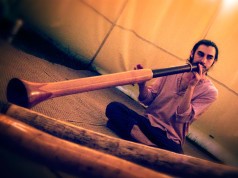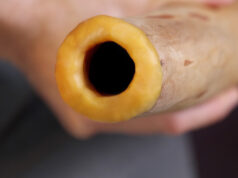Lip stretching is the fundamental warm-up for didgeridoo playing and it’s all about preparation. So before you touch the didge, before you buzz your lips, do these lip stretches. Also if someone comes to me and says they don’t know how to do didgeridoo lip buzzing, or they can’t even buzz their lips, I show them these lip stretches.
*Note everything we discuss in this article is covered in the video above.
Didgeridoo Lip Buzzing Technique #1: Lip Stretches
To start, take your two hands and you start pulling out your lips, stretching them gently. You don’t want to feel any pain but you do want to feel a nice stretch. Use your hands to stretch your lips one at a time, first top, then bottom, going side to side for 10 to 15 seconds. After you do the top, then do the same on the bottom.
For the next lip stretch you will suck in your lips and gently roll them over your teeth. First focus on the top lip for 10 to 15 seconds, then the bottom for the same amount of time. Do 3 rounds of this, top then bottom, top then bottom, top then bottom.
These exercises are really important for loosening up the lips and getting them ready for lip buzzing and didgeridoo playing.
Now try buzzing your lips. You should feel they are loose, but if they still feel a little stiff then take 5 or 10 minutes and do all the stretches again.
Didgeridoo Lip Buzzing Technique #2: Long tone buzzing
Now after you’ve really stretched your lips out, the next thing you should do (don’t play the didge yet) is to simply buzz your lips for about five minutes. These should be full breath long tones, i.e. inhale as much as you comfortably can, then exhale and buzz for the full duration of your breath until you are completely out of air. Use the support from your abdominal muscles to make this out breath go for as long as you can.
Didgeridoo Lip Buzzing Technique #3: Tighten the corners of your mouth
The third exercise I want to show you is tightening the corners of your mouth. This I actually learned from brass technique, playing the trombone for 12 years or so growing up. I don’t really play trombone much anymore but I pretty much translated a lot of those skills over to didgeridoo. So here’s what to do: when you buzz your lips there are a few different ways you can do it, from a very loose floppy buzz, to a tighter, higher pitched buzz. You will now start to develop control over the tightness of your buzz by tightening the corners of your mouth. Notice how that changes the frequency of the buzz, i.e., when the lips get tighter the buzz goes higher and when the lips get looser, the buzz goes lower. This technique of tightening and loosening allows you to buzz your lips at the same fundamental frequency of your didge and get the most refined sound possible.
The fundamental frequency of the didge is based on the length and dimensions of the instrument, so sometimes what might happen is there’s a didgeridoo there and you go to play it but your lips are either buzzing too loose or too tight and you don’t get a good sound. This is pretty common. If your lips are too loose or too tight you just won’t hit the drone, so whatyou need to do is adjust the tightness of your lips while you are playing the didge, until you hit the drone. Once you hit the drone, you stop adjusting the tightness and you hold your lips at that position. Control over this comes by tightening the corners of the mouth and using this muscle engagement to tighten and loosen the part of the lips that is buzzing. Sometimes I visualize this as pressing the lips together or pulling them apart vertically, i.e. squashing them towards each other or moving the jaw upward, or pulling them away from each other or bringing the jaw downward.
I highly suggest you watch the video for this exercise because even though I explained it in words, it will translate much better when you see me doing it on film.
So that is how i am finding the drone based on meeting the didge where it wants to naturally vibrate. These are just some essential didgeridoo playing techniques that i wanted to share with you guys because a lot of questions that people ask can be easily fixed by just these few basic things.
Taking your didgeridoo playing to the next level
If you are looking for more tips on how to get your didgeridoo playing going, I recommend that you check out our free Didgeridoo Fundamentals Course. It’s got 20 videos and a lot of great techniques that go beyond what we covered here, all of which will help you get a great didgeridoo sound and be playing at a higher level.
Thanks for tuning in and look out for more great didgeridoo tutorials coming your way here at Didge Project!












